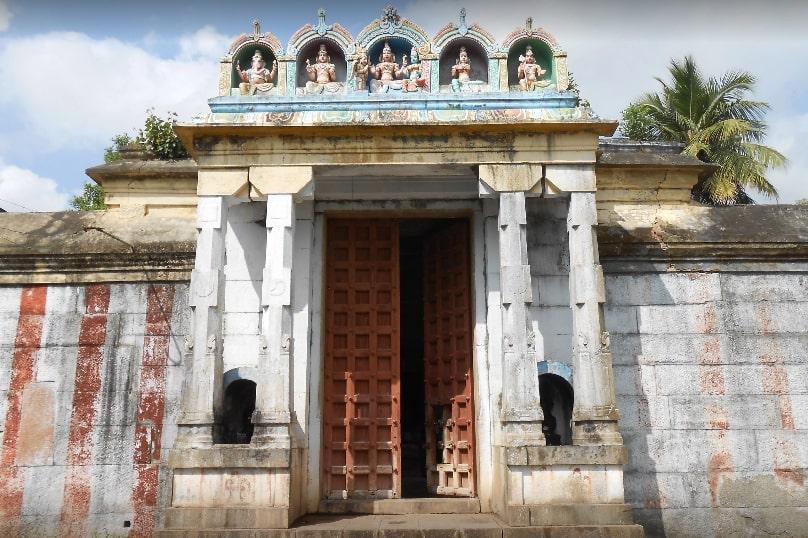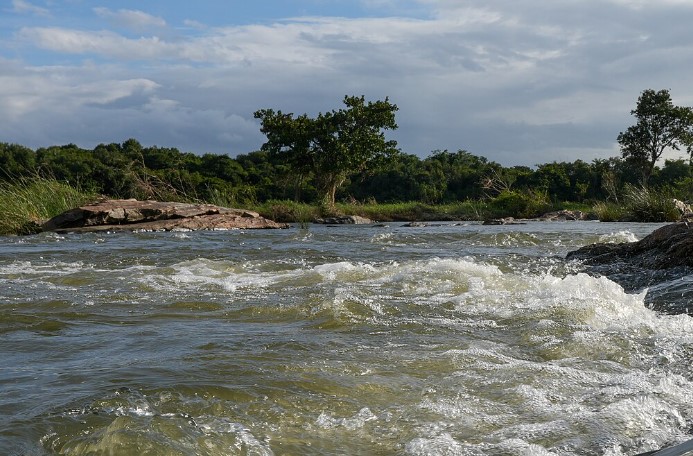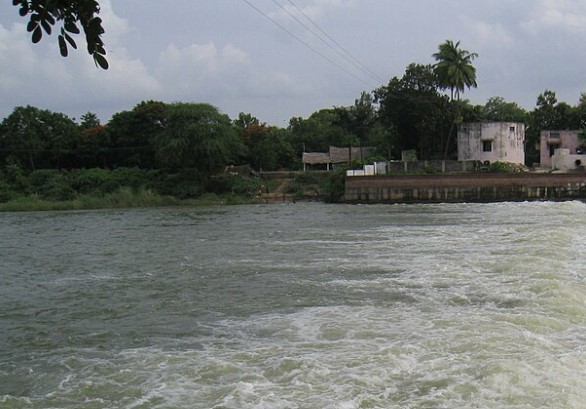The Thirunethranathar Temple, located in Thirupalli Mukkudal (historically known as Kekkarai) in the Thiruvarur District of Tamil Nadu, is one of the revered 276 Devara Paadal Petra Shiva Sthalams. This temple is significant as the 203rd Devara Paadal Petra Shiva Sthalam and the 86th on the southern bank of the river Cauvery in Chozha Nadu.
Key Features:
Deity: The presiding deity, Lord Shiva, is worshipped as Thirunethranathar (or Mukkona Nathar), while his consort, Goddess Parvati, is known as Mayilmevum Kanni (or Anjakshi).
Self-Manifested Lingam: The Shiva Lingam here is a Swayambumurthi, signifying its self-manifested nature.
Architecture: Unlike many temples, this one does not feature a main tower (Gopuram) but has an arch at the entrance. It consists of a single corridor (Prakaram) and lacks a flag post (Dwajasthambam).
Sacred Tree and Water: The temple's Sthala Vriksham (sacred tree) is the Vilwa, and the Theertham (holy water) is known as Shodasa (Mukkudal) Theertham.
Historical Significance: The site has deep historical roots, referenced in Thevaram hymns by the Tamil Saivite saint Thirunavukkarasar. The local lore connects it to Jadayu from the epic Ramayana, leading to its alternate name "Kuruvi Rameswaram."
Recent Events:
The most recent consecration ceremony (Maha Kumbabishekam) was conducted on January 27, 2003, with a prior ceremony on June 2, 1986.
This temple remains a vital part of the spiritual landscape in Tamil Nadu, reflecting rich cultural heritage and devotion.
PURANIC SIGNIFICANCE:
The Thirunethranathar Temple, dedicated to Lord Shiva, is rich in legend and cultural significance. The presiding deity is honoured as Sri Thrinethra Nathar in Sanskrit and Sri Mukkan Nathar in Tamil, though over time, the name evolved to Mukkona Nathar.
Legend of Jatayu
According to legend, Jatayu, a noble character from the Ramayana who sacrificed himself for Lord Rama, visited this site to perform penance. He prayed to Lord Shiva, seeking the chance to bathe simultaneously in Kasi (Varanasi), Allahabad, and Rameswaram to attain salvation. Pleased by Jatayu’s devotion, Lord Shiva granted him darshan and instructed him to protect Sita from Ravana. He foretold that Jatayu would lose his wings in this battle and ultimately die at Lord Rama’s feet.
Jatayu implored Lord Shiva to fulfil his wish of bathing in all three sacred sites before his demise. In response, the deity arranged for the waters of these Theerthams to converge at the temple's tank, assuring Jatayu that bathing there would be equivalent to the 16 sacred bathing places (Sethu Samudra Snana ghats) in Rameswaram. Hence, this tank is revered as Mukkoodal Theertham or Shodasa Sethu.
Other Legends
- Lord Vinayaka's Role: It is believed that Lord Vinayaka dug this tank for Sage Birungi Maharshi.
- Lord Rama's Worship: Legend suggests that Lord Rama worshipped Lord Shiva at this site and performed rituals for his father, King Dasaratha, similar to those he conducted in Gaya. This association led to the place being known as “Ganges Karai,” which later transformed into Kekkarai (Karai meaning riverbank in Tamil).
- The Chola King: A story from the Thiruvarur sthala puranam recounts a Chola king who would worship Lord Shiva before meals. A Chola king who was on hunting had to stay here for a night. He had the habit of taking the dinner only after Lord Shiva worship. The horseman made a Linga of the Kollu bag (the grain for horses) and enabled the king to do his Shiva puja before dinner. When he later tried to take the bag, he could not as it became a real Shivalinga, according to the history of the place.
- Queen Thapovadhani: Another tale involves Queen Thapovadhani, who prayed to the goddess for a child. The goddess is said to have appeared as a child on a lotus in the temple tank. The queen adopted the child, who was later married to Lord Shiva.
PURANIC SIGNIFICANCE 2:
Sri Rama performed Tharpan for his father Dasaratha here:
This is one of the places where Lord Sri Rama performed Tharpan for his father Dasaratha.
Performing Tharpan in this tank is considered equal to performing Shrardha for ancestors in Gaya.
Hence, the place is named Kekkarai.
12 Theertham Wells:
There are 12 wells in the temple tank.
The devotee derives the benefit of bathing in the Maha Magam tank if he/she bathes here.
Also bathing in this temple for 12 new moon days without a break will relieve the devotees of delays in their weddings and also concerns about the welfare of children.
Lord in the guise of Brahmana married Mother:
Mother Ambica is praised as Mayil Mevum Kanni.
A queen, Tapovadahani by name, worshipped Ambica seeking child boon. Responding to her prayer, Mother appeared as a child on a lotus leaf.
The queen was happy to have the child and brought her up.
When the child grew and attained the marriageable age, Lord came in the guise of a Brahmin and married her, according to the Sthala Purana.
Jatayu Moksham:
- Jatayu, an unforgettable character in epic Ramayana who laid his life in the service of Lord Sri Rama performed penance on Lord Shiva here seeking his grace to help him simultaneously bathe in Kasi (now Varanasi) and Rameswaram and attain salvation.
- Pleased with his penance and his noble aim, Lord appeared before him and said that he would be fighting with Ravana to rescue Mother Sita from his abduction attempt when his wings would be cut off by Ravana.
- When he would be in acute pain, Sri Rama would come there and that he would be giving the information about the direction Sita was taken by Ravana.
- Jatayu would fall at his feet and attain salvation.
- Jatayu asked back how he would be able to fly and bathe in Kasi and Rameswaram if his wings were cut off by Ravana.
- Lord replied saying that Jatayu wanted only one Sethu Samudra Sanana but bathing in the tank of this temple was equal to bathing in 16 Sethu Snana Ghats.
- It is said that this tank was dug by Lord Vinayaka during Brungi Maharishi period.
Equivalent to Triveni Sangamam:
This Theertham-tank is equal to the Triveni confluence of Ganga, Yamuna and Saraswathi, hence praised as Mukkudal meaning the confluence of three Theerthams.
Kollu Bag turning into Shiva Linga:
A Chola king who was on hunting had to stay here for a night. He had the habit of taking the dinner only after Lord Shiva worship.
The horseman made a Linga of the Kollu bag (the grain for horses) and enabled the king to do his Shiva puja before dinner.
When he later tried to take the bag, he could not as it became a real Shivalinga, according to the history of the place.
Other Names:
Ariyan Palli and Kuruvi Rameswaram are the historical names of this place.
Devotees
The temple is believed to have been graced by numerous revered figures, including Lord Rama, Jatayu, Sage Moorkka, and Saint Thirunavukkarasar, who all worshipped the lord at this sacred site.
The Thirunethranathar Temple stands as a testament to the intertwining of devotion, legend, and cultural heritage in Hindu tradition.
Historical Significance:
This temple is linked to the legendary figures of Jatayu and Lord Rama, earning it the name Kuruvi Rameswaram (where "Kuruvi" means bird in Tamil). There is also a Ramaswamy Temple located behind this Shivastalam.
Recent Renovation:
The temple has undergone recent renovations by the Naattukkottai Nagarathar (Chettiars), ensuring its preservation and continued significance in the community.
The Thirunethranathar Temple not only serves as a place of worship but also embodies the rich cultural and spiritual heritage of the region.
ADMINISTRATION:
The Thirunethranathar Temple is typically managed under the administration of the Hindu Religious and Charitable Endowments Department (HRCE) of Tamil Nadu. This department oversees the administration, maintenance, and governance of temples across the state, ensuring that they operate according to traditional practices and provide services to devotees. Local temple committees may also play a role in the day-to-day management and activities of the temple.


